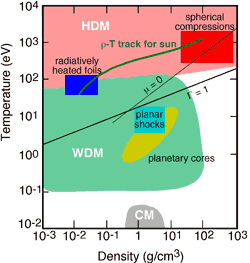High Energy Density Science Instrument
PURPOSE: The High Energy Density (HED) Science instrument at the LCLS will enable the detailed study of states of matter created when normal condensed matter is suddenly heated to very high temperatures, well above melting.
During the brief period (picoseconds) before this matter flies apart, it can form transient phases with properties very different both from the low-temperature condensed phase and from the high-temperature rarified plasma phase. These so-called HED phases are of interest to scientists studying astrophysics, planetary physics, fusion energy and the transition region from condensed matter to hot dense plasmas. Studying them experimentally has been nearly impossible in the past, and theoretical treatment is so complex as to be unreliable.

The temperature-density phase diagram for hydrogen shows the regimes of Hot Dense Matter (HDM) and Warm Dense Matter (WDM). The regime where the standard weakly-coupled plasma theory breaks down is the region below the line?G=1.? The HDM regime is relevant to laser/solid plasma interactions, x-ray heated foils, fusion science, and astrophysical plasmas. The WDM region is relevant to planar shocks, planetary cores, and all plasma generation devices that start from solid density. The condensed matter phase is labeled CM. Each atomic element has a distinct phase diagram of this type.
INSTRUMENT CONCEPT: The need to create the HED states to be studied and to handle matter that will rapidly change defines the requirements for the HEDS instrument. Large optical lasers will be used for placing enough energy into a system a on time scale short enough to allow it to be heated, and then rapidly isolated and studied. The instrument will include two laser sources that are unique to the LCLS experiments. One laser will provide large amounts of energy (>5 kJ) in pulse durations adjustable from 1 to 120 ns. The 1 ns pulses will create the plasma states typical of the HDM regime, while longer pulses will be used to create high-pressure WDM states for the study of material properties at extreme conditions. LCLS hard x-ray pulses will be used to probe these HED states.
A second, ultrashort-pulse laser with up to 10 J in a pulse duration of 30 fs will be used both to create extreme states of matter, and to probe extreme states created either by the long-pulse laser or by the focused LCLS x-ray energy.
Due to the size of these lasers an independent laser hall will be needed.

A schematic view of the high-energy laser showing the scale of the building.
In addition to the special laser systems, there will be several unique diagnostics included in the HED instrument:
- An x-ray streak camera that can provide a spectrum or one-dimensional image as a continuous function of time, with sub-picosecond resolution.
- Two methods for observing the expansion of surfaces: 1) VISAR, which is a laser Doppler interferometer particularly useful for studies of long duration high-pressure states; and, 2) Fourier Domain Interferometer to measure motion on a nanometer scale with a time resolution commensurate with the short pulse laser duration.
- A high-resolution hard x-ray spectrometer coupled to the x-ray streak camera, and VUV-XUV spectrometers.
- A specialized x-ray scattering device which will provide a measure of the electron temperature, the number of ionized and bound electrons, a measure of the electron velocity distribution, and information on the collective, or wave-like, behavior of the heated matter.
UNIQUENESS: The combination of the high energy laser, the ultrashort-pulse intense laser and the LCLS x-ray laser will for the first time in the world provide a facility where HED matter can be created and probed in much the same manner as previous generation light sources probed condensed matter.
